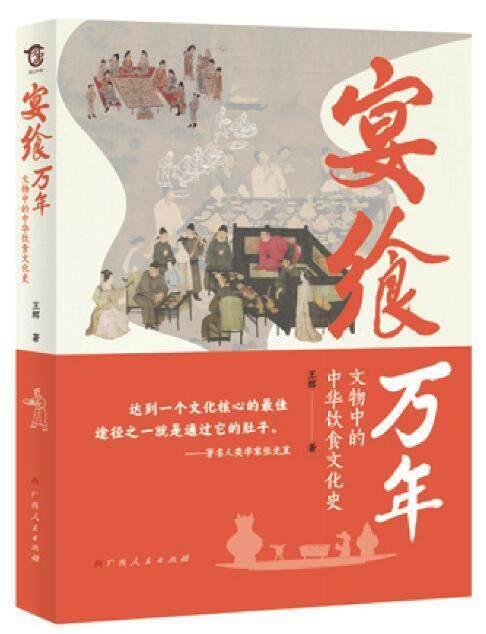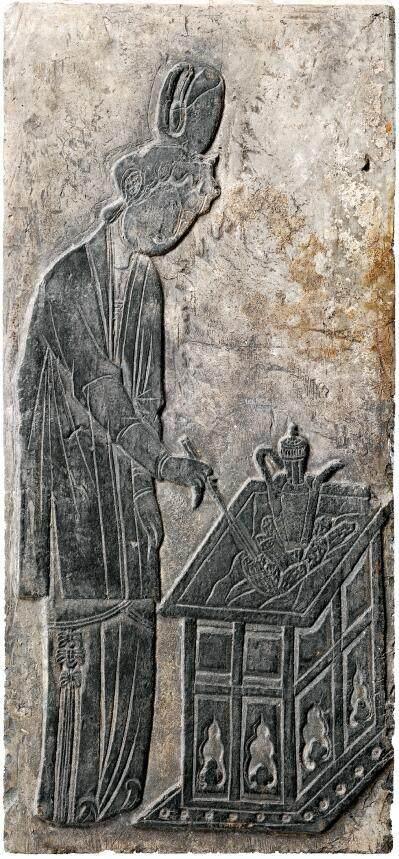The Past and Present of Chopsticks
2024-05-14



Authored by a senior curator at the National Museum of China, this book is based on the Ancient Chinese Dietary Culture Exhibition designed and carried out by the museum. It deeply explores historical documents and uses artifacts as the narrative thread, outlining the development of Chinese dietary culture over millennia. It elucidates ancient Chinese dietary culture from various angles, presenting a vivid and lively depiction of this aspect of ancient Chinese life in clear and simple language.
A Feast for Ten Thousand Years: A History of Chinese Culinary Culture Through Artifacts
Wang Hui
Guangxi Peoples Publishing House
February 2024
88.00 (CNY)
Wang Hui
Wang Hui, a research curator at the National Museum of China, primarily focuses on the history of the Qin and Han dynasties and the history of dietary culture. He has undertaken content planning work for exhibitions such as the Ancient Chinese Dietary Culture Exhibition and the Boundless Seas and Lands: Archaeological Achievements Exhibition of the Qin and Han Dynasties in Guangzhou at the National Museum of China.
Today, more than 1.6 billion people worldwide use chopsticks, meaning one in every five people eats with chopsticks. For us Chinese, the significance of chopsticks far surpasses that of the spoon. Living with chopsticks day and night, one could truly say, “Not a day can pass without this noble one!” The name for chopsticks has evolved several times throughout history, called “梜 jia” (also written as “莢 jia”) in the pre-Qin period. In the Qin and Han periods, they were referred to as “zhu” (筯 and 箸). By the Tang Dynasty, 筯 and 箸 (both pronounced “zhu”) were used interchangeably. Although from the Tang to the Qing Dynasty, chopsticks were uniformly referred to as “zhu,” the transition from “zhu” to “kuai” as the name for chopsticks began in the Ming Dynasty. The initial reason was a taboo among the folk, especially among boatmen and fishermen in the Suzhou area, who avoided the word “zhu” because it sounded the same as “to stay” or “to stop,” which was considered inauspicious for sailing. Thus, the term for chopsticks was changed to “kuai zi.” Subsequently, with the prevalence of secular literature and the translation of foreign cultures, “kuai zi” eventually became the most widespread and primary term used.
Before using chopsticks to eat, our ancestors ate by grabbing food with their hands. Intelligent ancestors wrapped millet in leaves and roasted it in mud over fire. To ensure even cooking, they stirred it continuously with sticks, leading to the initial form of chopsticks. The ancient term for chopsticks, “zhu,” consisted of the character for bamboo with an additional component implying aid, denoting a tool designed to assist in eating. Ancient people discovered the method of using small sticks to stir food and gradually fixed the number of sticks to two, improving their skill in using these sticks until they could manipulate them with flexibility. Archaeologists have unearthed 42 bone sticks at the Neolithic site of Longqiu Zhuang in Gaoyou, Jiangsu, which some scholars believe to be the prototypes of bone chopsticks, the earliest chopsticks in China. However, some scholars question this view, as similar bone sticks have been found at other Neolithic sites and are generally considered to be hairpins. Records of the Grand Historian mentions “Zhou using ivory chopsticks,” indicating that King Zhou once dined with ivory chopsticks. The use of finely crafted ivory chopsticks by King Zhou of the Shang Dynasty indicates that chopsticks were in use more than 3,000 years ago. The earliest bone chopsticks to date were found in a tomb at the Yin Ruins in Anyang, consisting of bronze chopstick heads used with handles.
In the pre-Qin period, eating methods included using hands as well as utensils like chopsticks, spoons, and forks. Because the traditional method of grabbing food with fingers was still predominantly used, chopsticks were not widely adopted. Zuo Zhuan recounts that the people of Chu gifted Duke Ling of Zheng with a large turtle. Before their audience, Prince Songs index finger began to tremble spontaneously, prompting him to show Zi Jia, boasting, “Whenever this occurs, Im about to taste something uniquely delicious.” Upon entry, they indeed saw the chef ready to slice the turtle, sharing a knowing laugh. Duke Ling of Zheng, curious about their laughter, was then informed by Zi Jia of the preceding events. After the chef finished cooking the turtle, Duke Ling summoned Prince Song but intentionally did not let him eat. Enraged, Prince Song abruptly dipped his finger into the pot, tasted its flavor, and then stormed out. The actions of “finger moving” and “dipping finger into the pot” in this story are indicative of eating with hands.
The Book of Rites states: “When sharing a meal, do not moisten your hands, do not form rice into balls, and do not return excess rice to the dish.” According to Zheng Xuan, “Do not moisten your hands” specifically means not to rub or knead them. Why shouldnt you “moisten your hands”? Because doing so can cause sweating on the hands, and using sweaty hands to grab food is unhygienic. What does “do not roll rice” mean? It refers to the action of rolling rice into balls with your hands. And “do not put back rice” means not to put excess rice from your hands back into the serving dish. Thus, the full meaning of this passage is that when eating with others, one should pay attention to hand cleanliness, not roll the rice into balls, and not put excess rice back into the serving dish.
These two examples indicate that, although chopsticks had already been invented, people during the pre-Qin period indeed continued to practice the traditional method of eating with their hands. In fact, for a long period afterward, the tradition of eating with hands persisted in some remote areas.
During the Han Dynasty, eating with chopsticks became common. Archaeological discoveries have shown that, in addition to bronze chopsticks, bamboo chopsticks were prevalent in the Han Dynasty. Numerous bamboo chopsticks were unearthed in tombs at locations such as the Mawangdui Han Dynasty Tomb in Changsha, Hunan, the Da Fentou site in Yunmeng, Hubei, and Phoenix Mountain in Jiangling. The bamboo chopsticks from the Mawangdui Han Dynasty tombs were placed on lacquer trays, whereas those unearthed from the Yunmeng and Jiangling Han tombs were generally stored in bamboo chopstick holders. According to Guangya: Explanations of Utensils, chopstick cases are also called “zuan.” East Han archaeological discoveries predominantly include bronze chopsticks, with bamboo chopsticks being less common. For instance, copper chopsticks were unearthed from an Eastern Han Dynasty tomb on Xianlie Road, Guangzhou. Additionally, wooden chopsticks were discovered at a house site in the “Jingjuedi” of Xinjiang during the Han Dynasty, indicating that the Central Plains practice of using chopsticks had spread to remote areas.
Han and Jin Dynasty stone reliefs and bricks also depict images of eating with chopsticks. The Image of Xing Qu Feeding His Father is a common filial piety story found in Han Dynasty stone reliefs. Xing Qus mother died early, and he lived with his father, who was unable to eat independently due to old age. Xing Qu personally fed him. In the image, the father sits on a bed while Xing Qu kneels in front of him, holding chopsticks in one hand and supporting his father with the other, feeding him.
During the Sui and Tang dynasties, the materials for chopsticks diversified, with archaeological discoveries and records mentioning gold, silver, and rhinoceros horn chopsticks. The earliest known silver chopsticks were found in the tomb of Li Jingxun. In the Song, Liao, Jin, and Yuan dynasties, archaeological findings frequently include silver chopsticks, such as the five pairs of silver chopsticks from the Yuan Dynasty in Anhui province, now in the collection of the National Museum of China. Additionally, wooden chopsticks were also found, as illustrated by the mural in a Liao tomb at Balin Left Banner, Chifeng, Inner Mongolia, depicting three Khitan men with shaved heads, one of whom is holding a lacquered plate with wooden chopsticks and other dining utensils in both hands.
During the Ming and Qing dynasties, chopstick styles became similar to those of modern times, with a square head and round foot being the most popular designs. The chopsticks used by the empresses of the Qing Dynasty were made of extremely precious materials and were exquisitely crafted, including gold and silver inlaid with jade, copper plated with gold, red sandalwood inlaid with jade, ivory chopsticks, and ebony chopsticks, epitomizing luxury. The National Museum of China holds a knife with chopsticks embedded in a coral-inlaid silver scabbard, which has a leather sheath connected to a double dragon ring that can be attached to a belt. This small knife, typically used by the Mongolian ethnic group for cutting food and also as a decorative item for men, has a pair of chopsticks inserted in the sheath, reflecting the influence of Han Chinese dietary customs.
杂志排行
中国新书(英文版)的其它文章
- Dujiangyan
- Traditional Chinese Crafts in the Context of Silk Road Civilization -- Interview with Master Li Maodi, a Master of Zhuoni Tao Inkstone Making in Gansu’s Zhuoni
- Encounters and Cultural Boundaries Between East and West: Cultural Transmission Under the Belt and Road Initiative
- The Splendor of the Maritime Silk Road: A Major Theme of Globalization Leading to the Americas
- Revelations from the Civilizations of the Silk Road
- The Historical Context of the Silk Road
